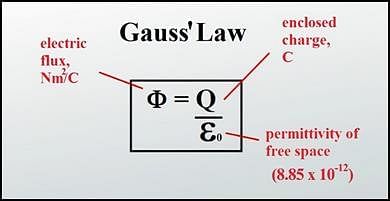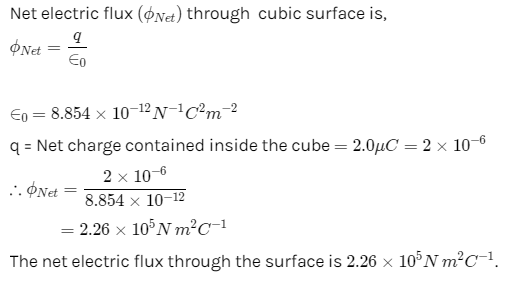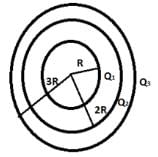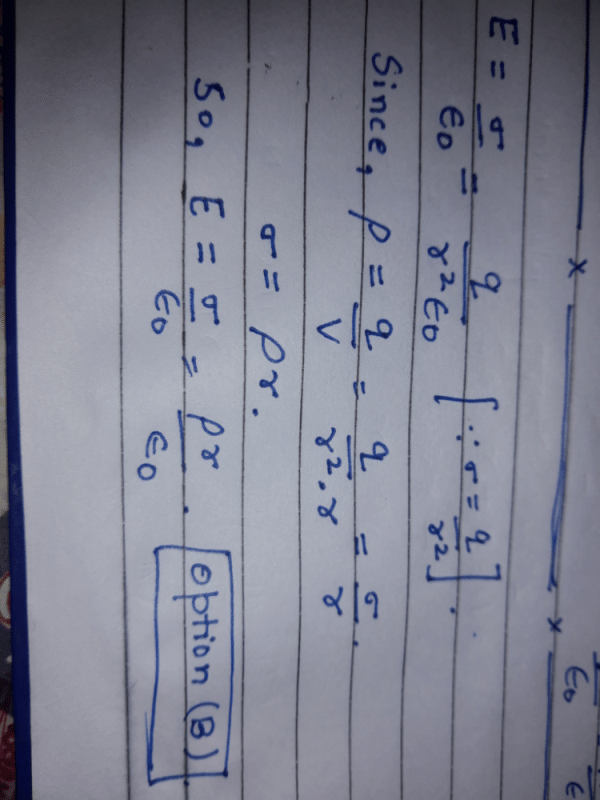All Exams >
Grade 9 >
AP Physics 2 >
All Questions
All questions of Electric Charges and Fields for Grade 9 Exam
The total negative charge in 1 mol of helium (atomic number 2, atomic mass 4) is:- a)

- b)

- c)

- d)

Correct answer is option 'A'. Can you explain this answer?
The total negative charge in 1 mol of helium (atomic number 2, atomic mass 4) is:
a)
b)
c)
d)
|
|
Isha Rane answered |
He atom has 2 electrons. so 1 mole of He has 2*N(N is Avohadro's no.) electrons. then total -ve charge in 1 mole He gas is 2*N*charge of 1 electron. calculating we will get about 1.9*10^5 C.
A point charge causes an electric flux of −1.0×103Nm2/C to pass through a spherical Gaussian surface of 10.0 cm radius centred on the charge. (a) If the radius of the Gaussian surface were doubled, how much flux would pass through the surface? (b) What is the value of the point charge? - a) 103Nm2/C,−7.8nC
- b) B 103Nm2/C,−8.8nC
- c) −103Nm2/C,−8.8nC
- d) −103Nm2/C,−6.8nC
Correct answer is option 'C'. Can you explain this answer?
A point charge causes an electric flux of −1.0×103Nm2/C to pass through a spherical Gaussian surface of 10.0 cm radius centred on the charge. (a) If the radius of the Gaussian surface were doubled, how much flux would pass through the surface? (b) What is the value of the point charge?
a)
103Nm2/C,−7.8nC
b)
B 103Nm2/C,−8.8nC
c)
−103Nm2/C,−8.8nC
d)
−103Nm2/C,−6.8nC
|
|
Mira Sharma answered |
A. Doubling the radius of Gaussian surface will not affect the electric flux since the charge enclosed is the same in both cases. Thus, the flux will remain the same i.e., –1.0 x 10^3 Nm^2/C
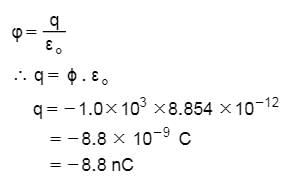
(b) Using gauss theorem,

If 109electrons move out of a body to another body every second, how much time is approximately required to get a total charge of 1 C on the other body?- a)120 years
- b)220 years
- c)200 years
- d)180 years
Correct answer is option 'C'. Can you explain this answer?
If 109electrons move out of a body to another body every second, how much time is approximately required to get a total charge of 1 C on the other body?
a)
120 years
b)
220 years
c)
200 years
d)
180 years
|
|
Naina Bansal answered |
we know that 1 Coulomb = 6.242�10^18 eletrons
given 10^9 electrons take 1 secs
=> 10^9 electrons ------> 1 sec
=> 1 electrons ---------> 1/(10^9) secs
=> 6.242�10^18 ------> 6.242�10^18/ (10^9)
= 6.242�10^9 secs = 6.242�10^9/ (60*60*24*365) years
=197.93 years
The total negative charge in 1 mol of helium (atomic number 2, atomic mass 4) is:- a)

- b)

- c)

- d)

Correct answer is 'A'. Can you explain this answer?
The total negative charge in 1 mol of helium (atomic number 2, atomic mass 4) is:
a)
b)
c)
d)

|
Tejas Desai answered |
He atom has 2 electrons. so 1 mole of He has 2*N(N is Avohadro's no.) electrons. then total -ve charge in 1 mole He gas is 2*N*charge of 1 electron. calculating we will get about 1.9*10^5 C.
If mica and woolen cloth are rubbed together, then mica gets- a)positively charged
- b)negatively charged
- c)remains neutral
- d)dual charged
Correct answer is 'A'. Can you explain this answer?
If mica and woolen cloth are rubbed together, then mica gets
a)
positively charged
b)
negatively charged
c)
remains neutral
d)
dual charged
|
|
Nisha Pillai answered |
Woolen cloth has +ve charge and when mica is rubbed on it , mica gets +vely charged due to (conduction) - flow of charge from wool to mica
The charge on a glass rod that has been rubbed with silk is called positive:- a)so that the proton charge will be positive
- b)because like charges repel
- c)to conform to the conventions adopted for G and m in Newton’s law of gravitation
- d)by arbitrary convention
Correct answer is 'D'. Can you explain this answer?
The charge on a glass rod that has been rubbed with silk is called positive:
a)
so that the proton charge will be positive
b)
because like charges repel
c)
to conform to the conventions adopted for G and m in Newton’s law of gravitation
d)
by arbitrary convention

|
Aravind Mehra answered |
When the point is on the diameter and away from the centre of hemisphere which is charged uniformly and positively, the component of electric field intensity parallel to the diameter cancel out. So the electric field is perpendicular to the diameter.
At any point on S on an electric field line - a)the perpendicular to the line is in the direction of at that point
- b)the tangent to the line is in the direction of at that point
- c)the binormal to the line is in the direction of at that point
- d)the curvature is in the direction of at that point
Correct answer is option 'B'. Can you explain this answer?
At any point on S on an electric field line
a)
the perpendicular to the line is in the direction of at that point
b)
the tangent to the line is in the direction of at that point
c)
the binormal to the line is in the direction of at that point
d)
the curvature is in the direction of at that point
|
|
Amar Shah answered |
Explanation:
Electric field lines are an imaginary construct that represent the direction of the electric field at any given point in space. These lines are always drawn perpendicular to the surface of the charged object. At any point on an electric field line, the tangent to the line is in the direction of the electric field at that point.
Explanation in points:
• Electric field lines represent the direction of the electric field at any given point in space.
• These lines are always drawn perpendicular to the surface of the charged object.
• At any point on an electric field line, the tangent to the line is in the direction of the electric field at that point.
• The electric field is a vector quantity, and its direction is given by the tangent to the field line at that point.
• The electric field is always perpendicular to the equipotential surfaces.
• The electric field lines are closer together where the electric field is stronger and farther apart where the electric field is weaker.
• The curvature of the electric field lines indicates the strength of the electric field at that point.
• The electric field lines always point from a higher potential to a lower potential.
• The electric field lines never cross each other, as this would imply that the electric field has two different directions at the same point.
• The electric field lines always terminate on charges or infinity.
• The electric field lines always start from a positive charge and end at a negative charge.
Electric field lines are an imaginary construct that represent the direction of the electric field at any given point in space. These lines are always drawn perpendicular to the surface of the charged object. At any point on an electric field line, the tangent to the line is in the direction of the electric field at that point.
Explanation in points:
• Electric field lines represent the direction of the electric field at any given point in space.
• These lines are always drawn perpendicular to the surface of the charged object.
• At any point on an electric field line, the tangent to the line is in the direction of the electric field at that point.
• The electric field is a vector quantity, and its direction is given by the tangent to the field line at that point.
• The electric field is always perpendicular to the equipotential surfaces.
• The electric field lines are closer together where the electric field is stronger and farther apart where the electric field is weaker.
• The curvature of the electric field lines indicates the strength of the electric field at that point.
• The electric field lines always point from a higher potential to a lower potential.
• The electric field lines never cross each other, as this would imply that the electric field has two different directions at the same point.
• The electric field lines always terminate on charges or infinity.
• The electric field lines always start from a positive charge and end at a negative charge.
Two equal positive charges q1 = q2 = 2.0 μC. μC are located at x = 0, y =0.3 and x =0 and y = -0.3 m respectively. What are the magnitude and direction of the total electric force (expressed in Newton and degrees counter clockwise w.r.t x - axis) that q1 and q2 exert on a third charge Q = 4.0 μC. μC at x =0.4 and y = 0 m- a)0.46,0.00
- b)0.44,2.00
- c)0.42,1.00
- d)0.48,3.00
Correct answer is option 'A'. Can you explain this answer?
Two equal positive charges q1 = q2 = 2.0 μC. μC are located at x = 0, y =0.3 and x =0 and y = -0.3 m respectively. What are the magnitude and direction of the total electric force (expressed in Newton and degrees counter clockwise w.r.t x - axis) that q1 and q2 exert on a third charge Q = 4.0 μC. μC at x =0.4 and y = 0 m
a)
0.46,0.00
b)
0.44,2.00
c)
0.42,1.00
d)
0.48,3.00
|
|
Ankita Datta answered |
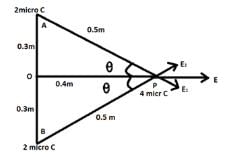
Side AP =  = 0.5m Electric Field due to charge at A on point P = Elecric Field due to charge at B on
= 0.5m Electric Field due to charge at A on point P = Elecric Field due to charge at B on 
 = 0.5m Electric Field due to charge at A on point P = Elecric Field due to charge at B on
= 0.5m Electric Field due to charge at A on point P = Elecric Field due to charge at B on 
point P 



Where  So force due to this field on charge P
So force due to this field on charge P
 So force due to this field on charge P
So force due to this field on charge PF = qE = 4 x 10-6 x 115.2 x 103 F = 0.46N
Since this force in the direction of positive x axis so angle = 00
Find the electric field inside the sphere which carries a charge density proportional to the distance from the origin
ρ = kr- a)ρ/ε0
- b)ρr/ε0
- c) ρr2/ε0
- d)none of the above
Correct answer is option 'B'. Can you explain this answer?
Find the electric field inside the sphere which carries a charge density proportional to the distance from the origin
ρ = kr
ρ = kr
a)
ρ/ε0
b)
ρr/ε0
c)
ρr2/ε0
d)
none of the above
|
|
Geetika Tiwari answered |
We can start by using Gauss's Law to find the electric field. Gauss's Law states that the flux of the electric field through any closed surface is proportional to the charge enclosed by the surface. Mathematically, it can be written as:
∮E⋅dA = Qenc/ε0
where E is the electric field, dA is an infinitesimal area element on the surface, Qenc is the charge enclosed by the surface, and ε0 is the permittivity of free space.
In this case, we can choose a spherical Gaussian surface centered at the origin, with radius r. The charge enclosed by this surface is:
Qenc = ∫ρdV
where ρ is the charge density and dV is an infinitesimal volume element. Since the charge density is proportional to the distance from the origin, we can write:
ρ = k r
where k is a constant of proportionality. The integral becomes:
Qenc = ∫ρdV = k ∫r^2sinθdrdθdφ
where the limits of integration are 0 to r for r, 0 to π for θ, and 0 to 2π for φ. Evaluating the integral gives:
Qenc = (4/3)πk r^3
Now we can apply Gauss's Law to find the electric field. The flux of the electric field through the Gaussian surface is:
∮E⋅dA = E(4πr^2)
where we have used the fact that the surface area of a sphere is 4πr^2. Therefore, Gauss's Law gives us:
E(4πr^2) = (4/3)πk r^3/ε0
Solving for E, we get:
E = k r/3ε0
Therefore, the electric field inside the sphere is proportional to the distance from the origin, with a constant of proportionality k/3ε0.
∮E⋅dA = Qenc/ε0
where E is the electric field, dA is an infinitesimal area element on the surface, Qenc is the charge enclosed by the surface, and ε0 is the permittivity of free space.
In this case, we can choose a spherical Gaussian surface centered at the origin, with radius r. The charge enclosed by this surface is:
Qenc = ∫ρdV
where ρ is the charge density and dV is an infinitesimal volume element. Since the charge density is proportional to the distance from the origin, we can write:
ρ = k r
where k is a constant of proportionality. The integral becomes:
Qenc = ∫ρdV = k ∫r^2sinθdrdθdφ
where the limits of integration are 0 to r for r, 0 to π for θ, and 0 to 2π for φ. Evaluating the integral gives:
Qenc = (4/3)πk r^3
Now we can apply Gauss's Law to find the electric field. The flux of the electric field through the Gaussian surface is:
∮E⋅dA = E(4πr^2)
where we have used the fact that the surface area of a sphere is 4πr^2. Therefore, Gauss's Law gives us:
E(4πr^2) = (4/3)πk r^3/ε0
Solving for E, we get:
E = k r/3ε0
Therefore, the electric field inside the sphere is proportional to the distance from the origin, with a constant of proportionality k/3ε0.
A tennis ball which has been covered with charges is suspended by a thread so that it hangs between two metal plates. One plate is earthed, while other is attracted to a high voltage generator. The ball- a)hangs without moving
- b)is attracted to the high voltage plate and stays there
- c)swings backward & forward hitting each plate in turn
- d)is repelled by earthed plate and stays there.
Correct answer is option 'C'. Can you explain this answer?
A tennis ball which has been covered with charges is suspended by a thread so that it hangs between two metal plates. One plate is earthed, while other is attracted to a high voltage generator. The ball
a)
hangs without moving
b)
is attracted to the high voltage plate and stays there
c)
swings backward & forward hitting each plate in turn
d)
is repelled by earthed plate and stays there.

|
Prashanth Banerjee answered |
Understanding the Scenario
A tennis ball covered with charges is suspended between two metal plates, one of which is earthed and the other connected to a high voltage generator. The behavior of the ball depends on the electric fields created by the charged plates.
Electric Charges and Forces
- The earthed plate is at zero potential, meaning it can freely accept or donate charges.
- The high voltage plate has a significant positive or negative charge, creating a strong electric field.
Interaction of the Tennis Ball
1. Induced Charges: The presence of the high voltage plate influences the tennis ball. The charges on the ball will rearrange themselves due to the electric field.
2. Attraction and Repulsion:
- If the high voltage plate is positively charged, it attracts negative charges from the ball and repels positive charges, leading to a net attraction towards it.
- Conversely, the earthed plate, being neutral, will attract the positive charges on the ball and repel the negative charges, creating a repulsive effect.
Movement of the Ball
- As a result of these attractive and repulsive forces, the ball will experience a swinging motion.
- The ball will swing back and forth between the two plates, hitting each one in turn, as it is continuously attracted to the high voltage plate and repelled by the earthed plate.
Conclusion
Hence, the correct answer is option 'C': the ball swings back and forth, hitting each plate in turn due to the interplay of electric forces from the charged plates. This demonstrates the fascinating effects of electric fields on charged objects.
A tennis ball covered with charges is suspended between two metal plates, one of which is earthed and the other connected to a high voltage generator. The behavior of the ball depends on the electric fields created by the charged plates.
Electric Charges and Forces
- The earthed plate is at zero potential, meaning it can freely accept or donate charges.
- The high voltage plate has a significant positive or negative charge, creating a strong electric field.
Interaction of the Tennis Ball
1. Induced Charges: The presence of the high voltage plate influences the tennis ball. The charges on the ball will rearrange themselves due to the electric field.
2. Attraction and Repulsion:
- If the high voltage plate is positively charged, it attracts negative charges from the ball and repels positive charges, leading to a net attraction towards it.
- Conversely, the earthed plate, being neutral, will attract the positive charges on the ball and repel the negative charges, creating a repulsive effect.
Movement of the Ball
- As a result of these attractive and repulsive forces, the ball will experience a swinging motion.
- The ball will swing back and forth between the two plates, hitting each one in turn, as it is continuously attracted to the high voltage plate and repelled by the earthed plate.
Conclusion
Hence, the correct answer is option 'C': the ball swings back and forth, hitting each plate in turn due to the interplay of electric forces from the charged plates. This demonstrates the fascinating effects of electric fields on charged objects.
Two point charges A and B, having charges +Q and –Q respectively, are placed at certain distance apart and force acting between them is F. If 25% charge of A is transferred to B, then force between the charges becomes- a)4F/3
- b)F
- c)9F/16
- d)16F/9
Correct answer is option 'C'. Can you explain this answer?
Two point charges A and B, having charges +Q and –Q respectively, are placed at certain distance apart and force acting between them is F. If 25% charge of A is transferred to B, then force between the charges becomes
a)
4F/3
b)
F
c)
9F/16
d)
16F/9

|
Ambition Institute answered |
In case I :


In Case II :

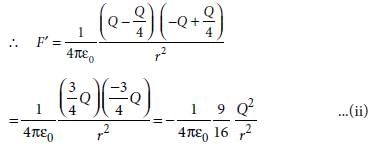
From equations (i) and (ii),



In Case II :


From equations (i) and (ii),

Electric field lines can be said to be - a)lines of equal Electric field
- b)drawing lines of electric fields
- c)lines of equal Electric voltage
- d)graphical representation of electric fields.
Correct answer is option 'D'. Can you explain this answer?
Electric field lines can be said to be
a)
lines of equal Electric field
b)
drawing lines of electric fields
c)
lines of equal Electric voltage
d)
graphical representation of electric fields.
|
|
Abhijeet Menon answered |
Explanation:Electric Field Lines can be defined as a curve which shows direction of electric field, when we draw tangent at its point. The concept of electric field was proposed by Michael Faraday, in the 19th century. He always thought that electric field lines can be used to describe and interpret the invisible electric field. Instead of using complex vector diagram every time, This pictorial representation or form is called electric field lines.Electric field lines can be used to describe electric field around a system of charges in a better way.
A hollow metal sphere of radius R is uniformly charged. The electric field due to the sphere at a distance r from the centre- a)decreases as r increases for r < R and for r > R
- b)increases as r increases for r < R and for r > R
- c)zero as r increases for r < R, decreases as r increases for r > R
- d)zero as r increases for r < R, increases as r increases for r > R
Correct answer is option 'C'. Can you explain this answer?
A hollow metal sphere of radius R is uniformly charged. The electric field due to the sphere at a distance r from the centre
a)
decreases as r increases for r < R and for r > R
b)
increases as r increases for r < R and for r > R
c)
zero as r increases for r < R, decreases as r increases for r > R
d)
zero as r increases for r < R, increases as r increases for r > R

|
Top Rankers answered |
In a uniformly charged hollow conducting sphere


Three point charges +q, –2q and +q are placed at points (x = 0, y = a, z = 0), (x = 0, y = 0, z = 0) and (x = a, y = 0, z = 0) respectively. The magnitude and direction of the electric dipole moment vector of this charge assembly are- a)√2qa along the line joining points (x = 0, y = 0,
z = 0) and (x = a, y = a, z = 0) - b)qa along the line joining points (x = 0, y = 0,
z = 0) and (x = a, y = a, z = 0) - c)√2qa along + x direction
- d)√2qa along + y direction
Correct answer is option 'A'. Can you explain this answer?
Three point charges +q, –2q and +q are placed at points (x = 0, y = a, z = 0), (x = 0, y = 0, z = 0) and (x = a, y = 0, z = 0) respectively. The magnitude and direction of the electric dipole moment vector of this charge assembly are
a)
√2qa along the line joining points (x = 0, y = 0,
z = 0) and (x = a, y = a, z = 0)
z = 0) and (x = a, y = a, z = 0)
b)
qa along the line joining points (x = 0, y = 0,
z = 0) and (x = a, y = a, z = 0)
z = 0) and (x = a, y = a, z = 0)
c)
√2qa along + x direction
d)
√2qa along + y direction

|
Stepway Academy answered |
This consists of two dipoles, –q and +q with dipole moment along with the +y-direction and –q and +q along the x-direction.
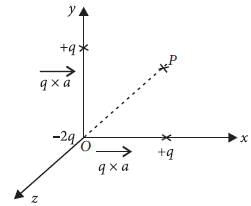

Along the direction 45° that is along OP, where P is (+a, +a, 0).


Along the direction 45° that is along OP, where P is (+a, +a, 0).
Ionization of a neutral atom is the - a)only gain of one or more electrons
- b)only gain of one or more protons
- c)gain or loss of one or more electrons
- d)only gain of one or more neutrons
Correct answer is option 'C'. Can you explain this answer?
Ionization of a neutral atom is the
a)
only gain of one or more electrons
b)
only gain of one or more protons
c)
gain or loss of one or more electrons
d)
only gain of one or more neutrons

|
Ashwin Yadav answered |
Explanation:It is not possible to remove or add protons to atom, but electron can be added or removed by an atom easily so charge can be developed on an atom by removing or adding electrons, by adding electrons it becomes negative charged ,by removing electrons it becomes positive charged.
Which among the following is safest to take protection from when lightning is expected to happen ?- a)Taking shelter below longer trees
- b)Taking shelter in a closed car
- c)Taking shelter in open field
- d)More than one of the above
Correct answer is option 'B'. Can you explain this answer?
Which among the following is safest to take protection from when lightning is expected to happen ?
a)
Taking shelter below longer trees
b)
Taking shelter in a closed car
c)
Taking shelter in open field
d)
More than one of the above

|
Manish Aggarwal answered |
- Lightning is caused because of the build-up of electrostatic charges in the clouds.
- The electrical conductors are carriers of electric charges and can be dangerous when used while Lightning.
- A closed car nullifies the effect of lighting taking place outside. So, it is the best place to hide. But open cars are dangerous.
- Usually, lightning does not affect short trees, and long trees are affected more. Though short trees provide good protection from lightning.
- The electric pole is too dangerous during lightning.
So, the correct option is Taking shelter in a car
If an object is positively charged, theoretically the mass of the object ______- a)Increases slightly by a factor of 9.11 x 10-31 kg
- b)Decreases slightly by a factor of 9.11 x 10-31 kg
- c)Remains the same
- d)May increase or decrease
Correct answer is option 'B'. Can you explain this answer?
If an object is positively charged, theoretically the mass of the object ______
a)
Increases slightly by a factor of 9.11 x 10-31 kg
b)
Decreases slightly by a factor of 9.11 x 10-31 kg
c)
Remains the same
d)
May increase or decrease

|
EduRev JEE answered |
If an object is positively charged it loses some of its electrons. The mass of an electron is 9.11 x 10-31 kg. So, if a positively charged body loses ‘n’ number of electrons, it mass decrease by the amount n x 9.11E-31kg.
When we rub a glass rod with silk, then- a)mass of silk decreases
- b)mass of glass rod and silk increases
- c)mass of glass rod increases
- d)mass of glass rod decreases
Correct answer is 'D'. Can you explain this answer?
When we rub a glass rod with silk, then
a)
mass of silk decreases
b)
mass of glass rod and silk increases
c)
mass of glass rod increases
d)
mass of glass rod decreases

|
Surbhi Sengupta answered |
when glass rod is rubbed with silk electrons are transferred from glass to silk, therefore the mass of glass rod decreases
A point charge Q is moved along a circular path around another fixed point charge The work done is zero - a)only if Q returns to it's starting position
- b)in all cases
- c)only if the two charges have the same magnitude and opposite signs
- d)only if the two charges have the same magnitude
Correct answer is option 'B'. Can you explain this answer?
A point charge Q is moved along a circular path around another fixed point charge The work done is zero
a)
only if Q returns to it's starting position
b)
in all cases
c)
only if the two charges have the same magnitude and opposite signs
d)
only if the two charges have the same magnitude

|
Vaishnavi Dasgupta answered |
Explanation:Since that circular path behave as equipotential surface so work done is always zero.
An electric dipole is placed at an angle of 30° with an electric field intensity 2 x 105 N C–1.It experiences a torque equal to 4 N m. The charge on the dipole, if the dipole length is 2 cm, is- a)8 mC
- b)2 mC
- c)5 mC
- d)7 μC
Correct answer is option 'B'. Can you explain this answer?
An electric dipole is placed at an angle of 30° with an electric field intensity 2 x 105 N C–1.It experiences a torque equal to 4 N m. The charge on the dipole, if the dipole length is 2 cm, is
a)
8 mC
b)
2 mC
c)
5 mC
d)
7 μC

|
Stepway Academy answered |
Here, q = 30°, E = 2 x 105 N C–1, τ = 4 N m,
l = 2 cm = 0.02 m, q = ?
τ = pE sinq = (ql)E sinq
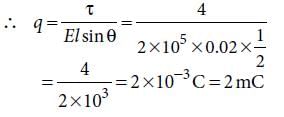
l = 2 cm = 0.02 m, q = ?
τ = pE sinq = (ql)E sinq

Quarks are entities that have- a)Fractional charges, combination of these are present in protons and neutrons
- b)integer charges, combination of these are present in protons, electrons and neutrons
- c)fractional charges, combination of these are present in protons and electrons
- d)no charge, combination of these are present in protons and electrons
Correct answer is option 'A'. Can you explain this answer?
Quarks are entities that have
a)
Fractional charges, combination of these are present in protons and neutrons
b)
integer charges, combination of these are present in protons, electrons and neutrons
c)
fractional charges, combination of these are present in protons and electrons
d)
no charge, combination of these are present in protons and electrons
|
|
Vivek answered |
There are two types of quarks present in protons and neutrons, up and down quarks with charges +⅔ and -⅓. In a proton, two up and one down quark are present whose charges add up to give a net charge of +1. In a neutron, one up and two down quarks are present whose charges add up to give a net charge of 0.
A hollow cylinder has a charge q coulomb within it. If f φ is the electric flux in units of volt meter associated with the curved surface B, the flux linked with the plane surface A in units of V-m will be

- a)

- b)

- c)

- d)

Correct answer is option 'D'. Can you explain this answer?
A hollow cylinder has a charge q coulomb within it. If f φ is the electric flux in units of volt meter associated with the curved surface B, the flux linked with the plane surface A in units of V-m will be


a)

b)

c)

d)


|
EduRev NEET answered |
Let φA, φB and φC are the electric flux linked with surface is A, B and C.
According to Gauss theorem,
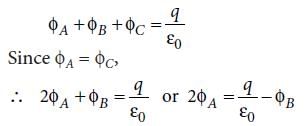

According to Gauss theorem,


A long, hollow conducting cylinder is kept coaxially inside another long, hollow conducting cylinder of larger radius. Both the cylinders are initially electrically neutral.- a)No potential difference appears between the two cylinders when same charge density is given to both the cylinders.
- b)No potential difference appears between the two cylinders when a uniform line charge is kept along the axis of the cylinders.
- c)A potential difference appears between the two cylinders when a charge density is given to the outer cylinder.
- d)A potential difference appears between the two cylinders when a charge density is given to the inner cylinder.
Correct answer is option 'D'. Can you explain this answer?
A long, hollow conducting cylinder is kept coaxially inside another long, hollow conducting cylinder of larger radius. Both the cylinders are initially electrically neutral.
a)
No potential difference appears between the two cylinders when same charge density is given to both the cylinders.
b)
No potential difference appears between the two cylinders when a uniform line charge is kept along the axis of the cylinders.
c)
A potential difference appears between the two cylinders when a charge density is given to the outer cylinder.
d)
A potential difference appears between the two cylinders when a charge density is given to the inner cylinder.

|
Juhi Deshpande answered |
Explanation:When the charge is given to inner cylinder than there is an electric field is produced between cylinders which is given by  and due to this a potential difference is developed between two cylinders.
and due to this a potential difference is developed between two cylinders.
A point charge + q is placed at the centre of a cube of side l. The electric flux emerging from the cube is- a)

- b)

- c)zero
- d)

Correct answer is option 'D'. Can you explain this answer?
A point charge + q is placed at the centre of a cube of side l. The electric flux emerging from the cube is
a)

b)

c)
zero
d)


|
Lead Academy answered |
Electric flux emerging from the cube does not depend on size of cube.


A toy car with charge q moves on a frictionless horizontal plane surface under the influence of a uniform electric field  . Due to the force
. Due to the force  , its velocity increases from 0 to 6 m s–1 in one second duration. At that instant the direction of the field is
, its velocity increases from 0 to 6 m s–1 in one second duration. At that instant the direction of the field is
reversed. The car continues to move for two more seconds under the influence of this field. The average velocity and the average speed of the toy car between 0 to 3 seconds are respectively- a)2 m s–1, 4 m s–1
- b)1 m s–1, 3 m s–1
- c)1 m s–1, 3.5 m s–1
- d)1.5 m s–1, 3 m s–1
Correct answer is option 'B'. Can you explain this answer?
A toy car with charge q moves on a frictionless horizontal plane surface under the influence of a uniform electric field  . Due to the force
. Due to the force  , its velocity increases from 0 to 6 m s–1 in one second duration. At that instant the direction of the field is
, its velocity increases from 0 to 6 m s–1 in one second duration. At that instant the direction of the field is
reversed. The car continues to move for two more seconds under the influence of this field. The average velocity and the average speed of the toy car between 0 to 3 seconds are respectively
 . Due to the force
. Due to the force  , its velocity increases from 0 to 6 m s–1 in one second duration. At that instant the direction of the field is
, its velocity increases from 0 to 6 m s–1 in one second duration. At that instant the direction of the field isreversed. The car continues to move for two more seconds under the influence of this field. The average velocity and the average speed of the toy car between 0 to 3 seconds are respectively
a)
2 m s–1, 4 m s–1
b)
1 m s–1, 3 m s–1
c)
1 m s–1, 3.5 m s–1
d)
1.5 m s–1, 3 m s–1

|
Ambition Institute answered |
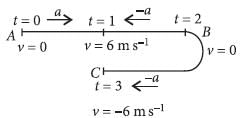
Acceleration 
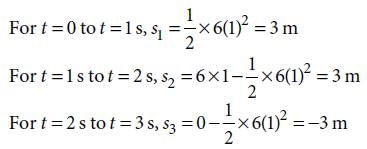






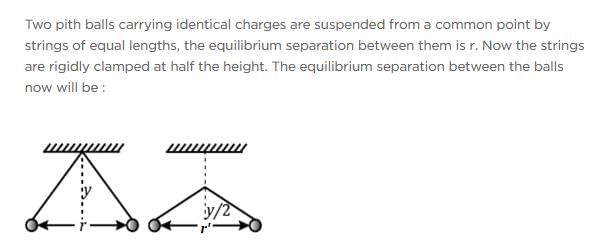
- a)

- b)

- c)

- d)

Correct answer is option 'D'. Can you explain this answer?

a)

b)

c)

d)


|
Ambition Institute answered |
Let m be mass of each ball and q be charge on each ball. Force of repulsion,
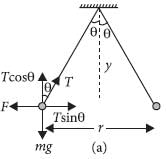

In equilibrium
Tcosq = mg ...(i)
Tsinq = F ...(ii)
Divide (ii) by (i), we get,

From figure (a),

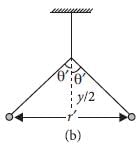

Divide (iv) by (iii), we get



In equilibrium
Tcosq = mg ...(i)
Tsinq = F ...(ii)
Divide (ii) by (i), we get,

From figure (a),



Divide (iv) by (iii), we get

A spherical conductor of radius 10 cm has a charge of 3.2 x 10–7 C distributed uniformly. What is the magnitude of electric field at a point 15 cm from the centre of the sphere?

- a)1.28 x 104 N/C
- b)1.28 x 105 N/C
- c)1.28 x 106 N/C
- d)1.28 x 107 N/C
Correct answer is option 'B'. Can you explain this answer?
A spherical conductor of radius 10 cm has a charge of 3.2 x 10–7 C distributed uniformly. What is the magnitude of electric field at a point 15 cm from the centre of the sphere?


a)
1.28 x 104 N/C
b)
1.28 x 105 N/C
c)
1.28 x 106 N/C
d)
1.28 x 107 N/C

|
Stepway Academy answered |
Here, r = 10 cm, q = 3.2 x 10–7 C


A charge Q is situated at the corner of a cube, the electric flux passed through all the six faces of the cube is- a)

- b)

- c)

- d)

Correct answer is option 'B'. Can you explain this answer?
A charge Q is situated at the corner of a cube, the electric flux passed through all the six faces of the cube is
a)

b)

c)

d)


|
Lead Academy answered |
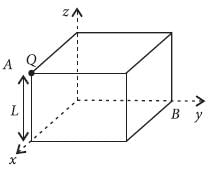
As at a corner, 8 cubes can be placed symmetrically, flux linked with each cube (due to a charge Q at the corner)
will be

Now for the faces passing through the edge A, electric field E at a face will be parallel to area of face and so flux for these three faces will be zero. Now as the cube has six faces and flux linked with three faces (through A) is zero, so flux linked with remaining three faces will be 
Hence, electric flux passed through all the six faces of the cube is

Hence, electric flux passed through all the six faces of the cube is

The charge on a glass rod that has been rubbed with silk is called positive:- a)so that the proton charge will be positive
- b)because like charges repel
- c)to conform to the conventions adopted for G and m in Newton’s law of gravitation
- d)by arbitrary convention
Correct answer is option 'D'. Can you explain this answer?
The charge on a glass rod that has been rubbed with silk is called positive:
a)
so that the proton charge will be positive
b)
because like charges repel
c)
to conform to the conventions adopted for G and m in Newton’s law of gravitation
d)
by arbitrary convention
|
|
Shubham Jain answered |
When the point is on the diameter and away from the centre of hemisphere which is charged uniformly and positively, the component of electric field intensity parallel to the diameter cancel out. So the electric field is perpendicular to the diameter.
A semi-circular arc of radius ' a ' is charged uniformly and the charge per unit length is λ. The electric field at the centre of this arc is- a)

- b)

- c)

- d)

Correct answer is option 'A'. Can you explain this answer?
A semi-circular arc of radius ' a ' is charged uniformly and the charge per unit length is λ. The electric field at the centre of this arc is
a)

b)

c)

d)


|
Lead Academy answered |
λ= linear charge density; Charge on elementary portion dx=λdx.
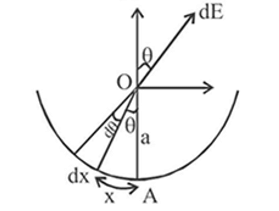
Electric field at
Horizontal electric field, i.e., perpendicular to AO, will be cancelled. Hence, net electric field = addition of all electrical fields in direction of AO =ΣdEcosθ
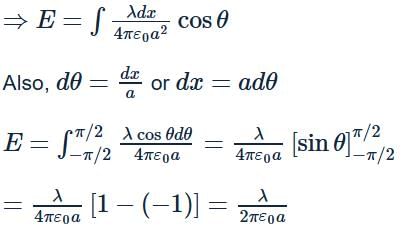

Electric field at

Horizontal electric field, i.e., perpendicular to AO, will be cancelled. Hence, net electric field = addition of all electrical fields in direction of AO =ΣdEcosθ

The charges 2q, -q, -q are located at the vertices of an equilateral triangle. At the circumcentre of the triangle
- a)the field is zero but potential is not zero.
- b)the field is non-zero but the potential is zero.
- c)both, field and potential are zero.
- d)both. field and potential are non-zero.
Correct answer is option 'B'. Can you explain this answer??
The charges 2q, -q, -q are located at the vertices of an equilateral triangle. At the circumcentre of the triangle
a)
the field is zero but potential is not zero.
b)
the field is non-zero but the potential is zero.
c)
both, field and potential are zero.
d)
both. field and potential are non-zero.
|
|
Tanishq Ghoshal answered |
Understanding the Problem
In this scenario, we have an equilateral triangle with charges placed at its vertices: 2q, -q, and -q. We need to analyze the electric field and electric potential at the circumcenter of the triangle.
Electric Field Analysis
- The electric field (E) due to a point charge is directed away from the charge if it is positive and towards the charge if it is negative.
- At the circumcenter, the contributions to the electric field from the charges can be calculated:
- The positive charge (2q) produces an electric field directed outward.
- Each negative charge (-q) produces an electric field directed inward towards itself.
- Due to symmetry, the electric fields from the two negative charges will cancel each other out in the horizontal direction, while the field from the positive charge adds to the net field.
- As a result, the net electric field at the circumcenter is non-zero.
Electric Potential Analysis
- The electric potential (V) due to a point charge is a scalar quantity and can be summed algebraically.
- The potential at the circumcenter is calculated as follows:
- V = (k * 2q/r) + (k * (-q)/r) + (k * (-q)/r), where r is the distance from the charges to the circumcenter.
- Simplifying this gives:
- V = (k/r) * (2q - q - q) = 0.
- Thus, the total electric potential at the circumcenter is zero due to the symmetry of the configuration.
Conclusion
Based on this analysis, we conclude that:
- The electric field at the circumcenter is non-zero.
- The electric potential at the circumcenter is zero.
Hence, the correct answer is option 'B': the field is non-zero but the potential is zero.
In this scenario, we have an equilateral triangle with charges placed at its vertices: 2q, -q, and -q. We need to analyze the electric field and electric potential at the circumcenter of the triangle.
Electric Field Analysis
- The electric field (E) due to a point charge is directed away from the charge if it is positive and towards the charge if it is negative.
- At the circumcenter, the contributions to the electric field from the charges can be calculated:
- The positive charge (2q) produces an electric field directed outward.
- Each negative charge (-q) produces an electric field directed inward towards itself.
- Due to symmetry, the electric fields from the two negative charges will cancel each other out in the horizontal direction, while the field from the positive charge adds to the net field.
- As a result, the net electric field at the circumcenter is non-zero.
Electric Potential Analysis
- The electric potential (V) due to a point charge is a scalar quantity and can be summed algebraically.
- The potential at the circumcenter is calculated as follows:
- V = (k * 2q/r) + (k * (-q)/r) + (k * (-q)/r), where r is the distance from the charges to the circumcenter.
- Simplifying this gives:
- V = (k/r) * (2q - q - q) = 0.
- Thus, the total electric potential at the circumcenter is zero due to the symmetry of the configuration.
Conclusion
Based on this analysis, we conclude that:
- The electric field at the circumcenter is non-zero.
- The electric potential at the circumcenter is zero.
Hence, the correct answer is option 'B': the field is non-zero but the potential is zero.
The total negative charge in 1 mol of helium (atomic number 2, atomic mass 4) is:- a)

- b)

- c)

- d)

Correct answer is 'A'. Can you explain this answer ?
The total negative charge in 1 mol of helium (atomic number 2, atomic mass 4) is:
a)
b)
c)
d)

|
Mrinalini Chopra answered |
He atom has 2 electrons. so 1 mole of He has 2*N(N is Avohadro's no.) electrons. then total -ve charge in 1 mole He gas is 2*N*charge of 1 electron. calculating we will get about 1.9*10^5 C.
Positive and negative point charges of equal magnitude are kept at ( 0,0,a/2) and (0,0,-a/2) respectively. The work done by the electric field when another positive point charge is moved from (-a,0,0) to (a,0,0) is
- a)Depends on the path connecting the initial and final positions
- b)Positive
- c)Negative
- d)Zero
Correct answer is option 'D'. Can you explain this answer?
Positive and negative point charges of equal magnitude are kept at ( 0,0,a/2) and (0,0,-a/2) respectively. The work done by the electric field when another positive point charge is moved from (-a,0,0) to (a,0,0) is
a)
Depends on the path connecting the initial and final positions
b)
Positive
c)
Negative
d)
Zero

|
Nisha Banerjee answered |
+Q charge is moving on equatorial line of dipole as shown in figure, since on equatorial line V=0 So W=0
Chapter doubts & questions for Electric Charges and Fields - AP Physics 2 2025 is part of Grade 9 exam preparation. The chapters have been prepared according to the Grade 9 exam syllabus. The Chapter doubts & questions, notes, tests & MCQs are made for Grade 9 2025 Exam. Find important definitions, questions, notes, meanings, examples, exercises, MCQs and online tests here.
Chapter doubts & questions of Electric Charges and Fields - AP Physics 2 in English & Hindi are available as part of Grade 9 exam.
Download more important topics, notes, lectures and mock test series for Grade 9 Exam by signing up for free.
AP Physics 2
65 videos|83 docs|37 tests
|

